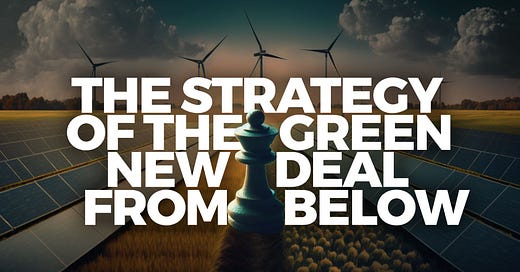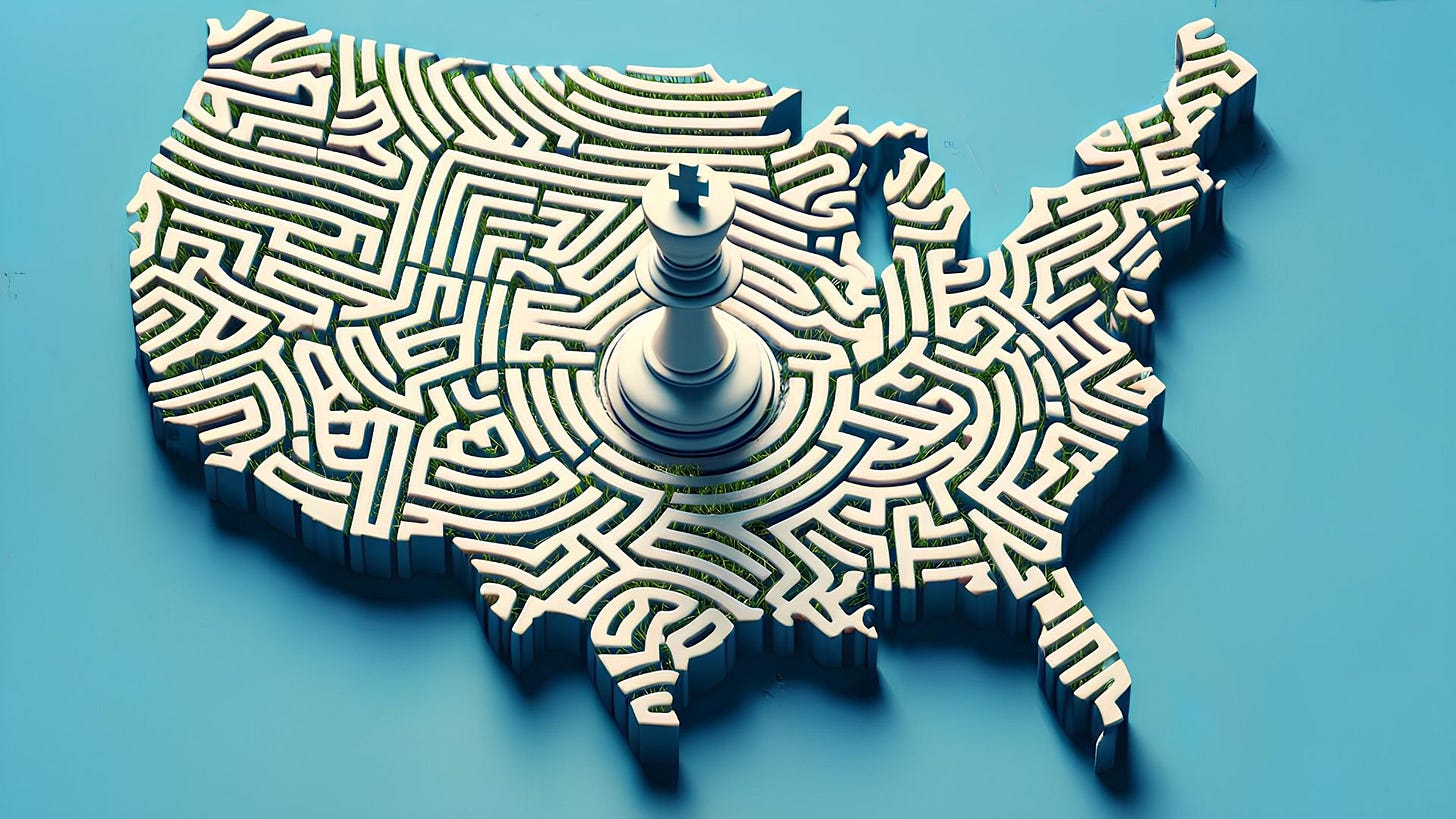The Strategy of the Green New Deal from Below
By Jeremy Brecher, Senior Strategic Advisor, LNS Co-Founder
Listen to the audio version >>
The Green New Deal from Below pursues strategic objectives that implement Green New Deal programs, expand the Green New Deal’s support, and shift the balance between pro- and anti-Green New Deal forces. Not every action is likely to accomplish all of these objectives, but most actions aim to accomplish more than one of them at the same time.
The first set of objectives aim to make concrete changes that accomplish the goals of the Green New Deal. Reducing greenhouse gas emissions is an objective of many actions, ranging from insulating urban housing to shutting down mines and power plants. Reducing injustice and inequality is similarly a goal of actions ranging from ensuring access to climate jobs for those who have been excluded from them to putting low-emission transit in vehicle-polluted neighborhoods. Another objective is improving the position of workers through such means as incorporating labor rights in climate legislation, establishing training and job ladders for climate jobs, and actively supporting the right of workers to organize and exercise their power. Green New Deal projects usually aim to accomplish these purposes synergistically, for example by designing climate-protection policies that also reduce injustice and empower workers on the job.
Green New Deal projects generally embody another set of objectives: educating and inspiring people. This happens through direct educational efforts like workshops, community forums, webinars, educational materials, and making known what has been accomplished elsewhere. Many programs involve basic education on climate, justice, and labor issues.
Campaigns like those for the Washington and Illinois clean energy and jobs acts involved long and extensive educational campaigns. But much of the inspiration and education provided by the Green New Deals takes the form of expanding the limits of what is believed to be possible by showing the power of people when they organize — and by constructing exemplary projects that inspire people to believe that more is possible. These exemplary actions produce powerful evidence for the value and feasibility of the Green New Deal.
Green New Deal from Below initiatives also support a shift in power. They bring into being organized constituencies and coalitions that can serve as political building blocks for more extensive Green New Deal campaigns. Green New Deal projects also create institutional building blocks, ranging from energy systems to transportation networks, that can become part of the economic and social infrastructure of a national Green New Deal. They help overcome the divisions and contradictions that weaken popular forces by engaging them around projects that embody common interests and a common vision. And they reduce the power of the anti-Green New Deal forces by dividing them, disorienting them, undermining their pillars of support, and even at times converting them.
The fight for the Green New Deal is inevitably entwined with the fight for democracy. Green New Deal from Below initiatives provide models for — and show the benefits of — popular democracy. Green New Deal from Below projects show that through collective action people can make concrete gains that benefit their real lives. They thereby contribute to building a base to protect and extend governance of, by, and for the people at every level. They represent a local embodiment of participatory democracy. And they create bastions for reinforcing representative democracy against fascism in the national arena.
The program of the Green New Deal, beneficial as it may be, is not in itself adequate to solve the deeper structural problems of an unjust and self-destructive world order. One of its strategic objectives, therefore, must be to open the way to wider, more radical forms of change.
Strategy on the Ground
Green New Dealers seek to realize these objectives in a world that is not of their own making, where powerful forces oppose their efforts. They have developed a multi-pronged strategy adapted to actually existing power relations.
The federal system of government provides obvious arenas for initiatives “from below.” While the power of state, county, and municipal governments is circumscribed by law and by the power of higher jurisdictions, experience shows that in fact the division of powers is flexible and can itself be challenged and changed. Cities and states have often won power over matters that they once seemed excluded from. For example, in the original New Deal era states engaged in such previously excluded programs as bank deposit insurance systems, publicly owned utilities, mortgage moratoriums; and bans on anti-strike injunctions.[1] Green New Deal states have similarly expanded their reach into previously federal domains such as regulation of tailpipe emissions and regional energy planning. And even within the established division of powers, Green New Deal states and municipalities have found extensive space for implementing energy, housing, transportation, healthcare, and many other dimensions of the Green New Deal program.
Acting in these arenas requires adapting strategy to the specific realities of the situation. For example, the powers of mayors, city councils, governors, and legislatures differ both constitutionally and in practice; what may seem unimaginable in one location may be achievable in another. Green New Dealers have used not only the institutions of representative democracy but, where they exist, institutions of direct democracy, for example in the “just transition” initiative in Washington state and several initiatives in California. Federalism and direct democracy provide a certain measure of dual power, in which initiatives can be taken even though they contradict national policy.
But Green New Deal from Below arenas are not limited to those established by governmental jurisdictions. Self-organization in civil society also provides locations in which power is developed and exercised. Unions, neighborhood organizations, ethnic and cultural groups, and other constituencies provide venues in which Green New Deal ideas and programs are contested. And they also can themselves implement Green New Deal programs like union training programs for green building maintenance, neighborhood-initiated solar gardens, and the plans for a community micro-grid in Boston’s Chinatown.
Green New Dealers operate within, alongside, and against the institutions and personnel of the political system. They are often active in supporting candidates. They are often members of political parties, usually the Democratic Party but occasionally third parties of various kinds. (If Green New Dealers are active anywhere in the Republican Party it’s a well-kept secret.) In some locations they form an identifiable Green New Deal wing of the Democratic Party. Candidates for mayor, governor, state legislator, and city councilor have run on Green New Deal platforms, for example Mayor Michelle Wu in Boston and Governor Jay Inslee in Washington. Pro-Green New Deal politicians have played a powerful role in building support for and implementing Green New Deal programs.
But the relation to elected officials and other political leaders varies. Politicians’ motives can range from personal commitment to the purest opportunism. In some cases, such as Mayor Wu in Boston, an elected official played a major role in bringing the Green New Deal coalition together and was widely accepted as the leader of a local or state Green New Deal. In the Somerville Green New Deal elected officials participated in forums and other activities developed by the coalition but organized labor remained in the lead. Frequently grassroots groups and coalitions recruit politicians to be advocates and to serve as champions for action in the legislative arena. In California Governor Gavin Newsom stood on the fence and was largely a target for pressure until at the last minute he endorsed a wide swath of Green New Deal-style legislation; thereafter he backtracked on some of the policies he himself had supported.
The initiative and support for Green New Deal programs often comes less from politicians than from coalitions of civil society organizations outside the formal political system. Even where political leaders have championed a Green New Deal vision, the impetus for actually designing and implementing Green New Deals has often come from forces in civil society. And at times Green New Dealers have had to pressure and even oppose political leaders who put themselves forward as champions of the Green New Deal – for example, self-proclaimed New York Green New Deal governor Andrew Cuomo, whose programs many Green New Dealers found woefully inadequate.
From its inception the Green New Deal has had an ambiguous and multifaceted relationship with the Democratic Party. Elements of the Democratic Party have supported, opposed, or maintained neutrality on the vision and policy of the Green New Deal. Green New Dealers have variously fought against, won over, and captured Democratic Party strongholds. Despite this tactical diversity, however, part of the Green New Deal’s overall strategy is to transform the Democratic Party both locally and nationally. This involves building a pro-Green New Deal bloc in the Democratic Party. And it involves using the Green New Deal program as a vehicle for bridging the environmentalist-labor divide within the Democratic Party.
Activists involved with the Seattle Green New Deal articulated many of these themes as they reflected on their experience of first winning and then implementing their city’s Green New Deal program. Youth leader Syris Valentine said, “This wouldn’t have happened without a strong grassroots campaign.” And Seattle 350 member Jess Wallach said their rapid success was due in equal parts to building robust relationships among community partners, maintaining public pressure on city officials, and forging an alliance with a supportive city council member. Taken together, these actions created a strong “inside-outside game.”
Faced with the wealth, concentrated power, and dominance of the political system and media wielded by its opponents, the Green New Deal pursues what is sometimes called an asymmetrical strategy – one that draws on different strengths and utilizes different tactics than its opponents. It outflanks its opponents by complementing action at the national level with action “from below.” It elevates perceptions of what is possible through collective action. It combines organization and action inside and outside mainstream institutions. It integrates program elements in ways that turn apparently conflicting interests into aligned ones. It draws together varied constituencies around common programs. It transcends the limits established by neoliberal orthodoxy. It makes action at a national level and a local level synergistic. And it creates concrete “facts on the ground” in the form of successful programs that are actually reducing climate-destroying pollution, creating jobs, reducing injustice, and improving people’s lives.
Can the Green New Deal overcome its opponents and achieve its objectives? There are no guarantees that it can. That depends on what people decide to do. As Gandhi once put it, “The matter resolves itself into one of matching forces.”
[1] For state New Deal programs, see Jeremy Brecher, “States of Change: What the Green New Deal Can Learn from the New Deal in the States,” Labor Network for Sustainability, November 9, 2020. https://www.labor4sustainability.org/files/LNSpdf_States_nov2020.pdf






